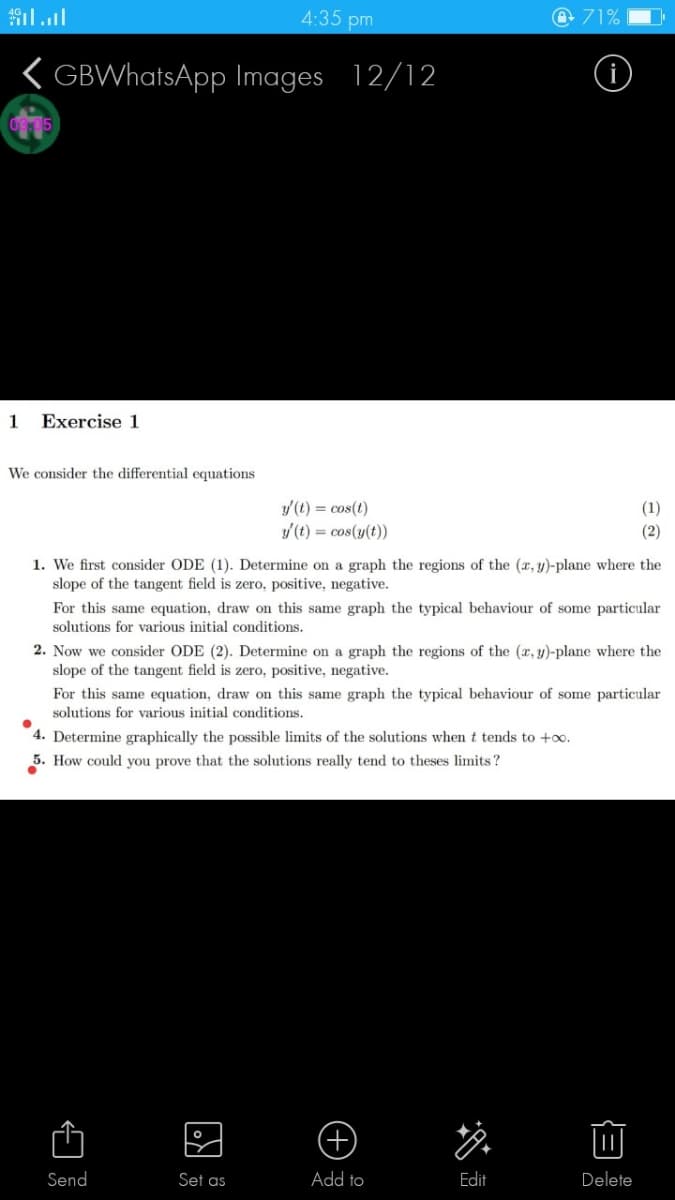consider the differential equations y/(t) = cos(t) %3D (t) = cos(ult))
Advanced Engineering Mathematics
10th Edition
ISBN:9780470458365
Author:Erwin Kreyszig
Publisher:Erwin Kreyszig
Chapter2: Second-order Linear Odes
Section: Chapter Questions
Problem 1RQ
Related questions
Question
100%
Solve all parts in one hour and take a thumb up plz

Transcribed Image Text:4:35 pm
71%
( GBWhatsApp Images 12/12
1
Exercise 1
We consider the differential equations
/(t) = cos(t)
y (t) = cos(y(t))
(1)
(2)
1. We first consider ODE (1). Determine on a graph the regions of the (x, y)-plane where the
slope of the tangent field is zero, positive, negative.
For this same equation, draw on this same graph the typical behaviour of some particular
solutions for various initial conditions.
2. Now we consider ODE (2). Determine on a graph the regions of the (r, y)-plane where the
slope of the tangent field is zero, positive, negative.
For this same equation, draw on this same graph the typical behaviour of some particular
solutions for various initial conditions.
4. Determine graphically the possible limits of the solutions when t tends to +o.
5. How could you prove that the solutions really tend to theses limits?
Send
Set as
Add to
Edit
Delete
Expert Solution
This question has been solved!
Explore an expertly crafted, step-by-step solution for a thorough understanding of key concepts.
Step by step
Solved in 2 steps with 2 images

Recommended textbooks for you

Advanced Engineering Mathematics
Advanced Math
ISBN:
9780470458365
Author:
Erwin Kreyszig
Publisher:
Wiley, John & Sons, Incorporated

Numerical Methods for Engineers
Advanced Math
ISBN:
9780073397924
Author:
Steven C. Chapra Dr., Raymond P. Canale
Publisher:
McGraw-Hill Education

Introductory Mathematics for Engineering Applicat…
Advanced Math
ISBN:
9781118141809
Author:
Nathan Klingbeil
Publisher:
WILEY

Advanced Engineering Mathematics
Advanced Math
ISBN:
9780470458365
Author:
Erwin Kreyszig
Publisher:
Wiley, John & Sons, Incorporated

Numerical Methods for Engineers
Advanced Math
ISBN:
9780073397924
Author:
Steven C. Chapra Dr., Raymond P. Canale
Publisher:
McGraw-Hill Education

Introductory Mathematics for Engineering Applicat…
Advanced Math
ISBN:
9781118141809
Author:
Nathan Klingbeil
Publisher:
WILEY

Mathematics For Machine Technology
Advanced Math
ISBN:
9781337798310
Author:
Peterson, John.
Publisher:
Cengage Learning,

